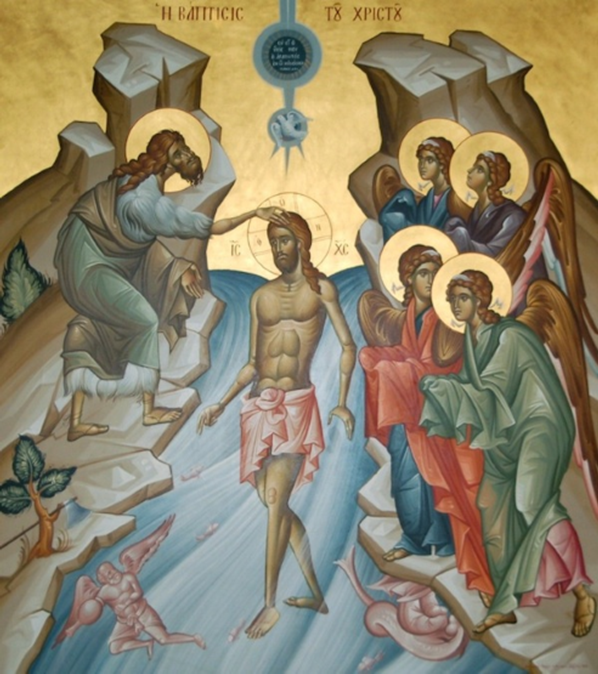THEOPHANY

THEOPHANY (from GR theophania) means shining forth or manifestation of God. The Old Testament contains many stories demonstrating God’s immense love for His creation and the extent to which He is willing to go in order to bring human beings into fellowship with Himself (God manifested Himself to Abraham, Jacob and Moses). In the New Testament, THEOPHANY marks the Baptism of Christ by the glorious Prophet and Forerunner John the Baptist. Christ’s baptism in the Jordan was “theophany” because it was the beginning of our Lord’s public ministry. It was also a “theophany” in that the world was granted a revelation of the Trinitarian nature of God: the Father's voice is heard from Heaven, the Son of God is incarnate and standing physically in the Jordan, and the Holy Spirit descends on Him in the form of a dove (Mt. 3:13-17; Mark 1:9-11; Luke 3:21-22; John 1:31-34.) The Icon of the Feast tells the story from the Gospels in images and color. The theme of “manifestation” or “revelation” is also expressed with the symbolism of light. In the hymn of the Feast we sing, “Christ has appeared and enlightened the world.” The Church celebrates on this day the illumination of the world by the light of Christ. THEOPHANY is one of the Great Feasts of the Orthodox Church, celebrated on January 6. In mystic commemoration of the Baptism of Christ in the Jordan, the Great Blessing of Water is performed. As the Troparion of the Feast is sung, the celebrant immerses the Cross into the water three times and then proceeds to sprinkle the water in the four directions of the world. The holy water so blessed is used by the priests to bless the homes of the faithful.
THÉOPHANIE
THÉOPHANIE (des radicaux grecs théo « dieu », et phan-, « apparition ») signifie manifestation divine. L'Ancien Testament contient de nombreuses histoires démontrant l'immense amour de Dieu pour Sa créature et les efforts qu'Il pouvait déployer pour amener les êtres humains à Lui (Dieu s'est manifesté à Abraham, Jacob et Moïse). Dans le Nouveau Testament, la THÉOPHANIE commémore le baptême de Notre Seigneur par Jean le Précurseur dans les eaux du Jourdain, et plus généralement, la manifestation publique du Verbe incarné aux hommes - le début du ministère public de notre Seigneur. L'aspect de gloire de la THÉOPHANIE consiste en la révélation de la nature trinitaire de Dieu: la voix du Père est entendue du Ciel, le Fils de Dieu se tient physiquement dans le Jourdain, et le Saint-Esprit descend sur Lui sous la forme d'une colombe (Mt 3: 13-17; Marc 1: 9-11; Luc 3: 21-22; Jean 1: 31-34.) L'icône de la fête raconte l'histoire des Évangiles en images et en couleurs. En outre, le thème de la «manifestation» ou de la «révélation» s'exprime avec le symbolisme de la lumière. Dans le Kondakion de la Fête, nous chantons: «Seigneur, tu t'es manifesté et sur nous resplendit ta lumière ; c'est pourquoi en pleine connaissance nous te chantons ; tu es venu et t'es manifesté, Lumière inaccessible.». L'Église célèbre ce jour l'illumination du monde par la lumière du Christ. La THÉOPHANIE est l'une des Douze Grandes Fêtes de l'Église orthodoxe, célébrée le 6 janvier. Alors que le Troparion de la Fête est chanté, le célébrant plonge la Croix dans l'eau trois fois, puis procède à l'aspersion de l'eau dans les quatre directions du monde. L'eau bénite est alors utilisée par le clergé pour bénir les maisons des fidèles.